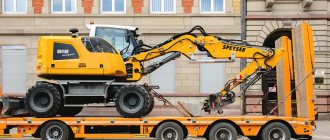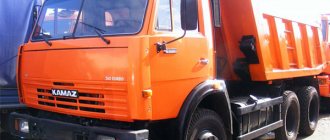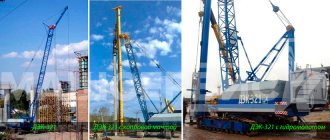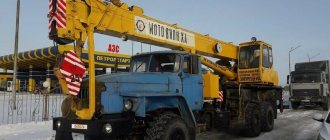Trucks can transport a variety of objects, from fragile sculptures to perishable foods. Size, length, width, dimensions and load capacity of the truck - the choice of the listed parameters depends on the type of items being delivered.
When it comes to large loads, Euro trucks are most often used. The popularity of such a vehicle is due to the speed of delivery and cost-effectiveness. Below we will analyze the most common models and list their characteristic features.
What is a Eurotruck?
This is the name given to a semi-trailer together with a tractor that has certain characteristics or parameters close to them. It is used for transporting large-sized cargo weighing up to 25 tons with a volume of up to 120 cubic meters.
The main advantage of these trucks is their versatility and flexibility in operation. One type of trailer or another can help you transport most different goods.
This is what loading a tilt Euro truck looks like:
The most common and used type is the tractor-trailer . However, the cargo compartment can also be insulated, refrigerated or open.
Features of transportation of oversized cargo
Oversized cargo is a cargo whose weight and dimensions exceed the permitted limits. Transportation of goods exceeding the established dimensions is, in principle, permissible, but must be carried out in compliance with a number of special conditions provided for in paragraph 23 of the Road Traffic Rules of the Russian Federation. So, if the cargo protrudes from the rear by more than 1 meter, and from the side by more than 40 cm, it is marked with identification signs “Large cargo”, as well as lights and reflectors in white (front) and red (rear).
The movement of oversized cargo protruding from the rear by more than 2 meters and exceeding 4 meters in height, as well as road trains, is carried out according to special rules established by regulations of the Government and order of the Ministry of Transport of 2012 number 258:
- the route of movement of a heavy and (or) large-sized transporter is agreed upon in advance;
- special permits for the transportation of oversized cargo on public federal highways are issued by an authorized body, namely the Federal Road Agency;
- movement along the route is accompanied by patrol cars of the traffic police or military traffic police;
- If, after passing an oversize vehicle, the road surface or other elements of the road infrastructure are damaged, the owner of the vehicle is obliged to compensate for the damage caused.
Exceeding the weight and dimensions when transporting goods while ignoring specially established rules is a violation of traffic rules and entails administrative liability.
Average parameters
Different types of bodies have their own unique characteristics, such as internal length and width, cubic capacity, and loading area. Each of them is best suited for an individual task.
Below is a summary table with parameter ranges for various trailers:
| Parameter | From | Before |
| Inner length | 8 m | 13.8 m |
| Width | 2.4 m | 2.45 m |
| Height | 2.3 m | 3m |
| Load capacity | 12 t | 25 t |
| Useful volume | 50 m3 | 120 m3 |
How to calculate useful volume
To find out the total capacity, you need to take into account three parameters at once: the length, thickness and height of the semi-trailer. You should understand the technical specifications in order to imagine what and how can be located in the vehicle.
In this case, the calculation formula is extremely simple: you need to multiply the above values. The resulting number is the same desired value. However, when filling the space of the truck, do not forget about the errors. It's better to always leave a small reserve.
The dimensions and width of the awning body, as well as the cubic capacity of the truck, are determined by the specific model. Drivers working on different cars should not forget about possible differences.
Dimensional characteristics of the eurotruck
The dimensions of a Eurotruck depend on the tasks it solves, and therefore for each cargo, as well as for any logistics problem, there is a suitable and optimal solution. Options such as a tilt or flatbed truck will provide greater flexibility during loading and the ability to transport long items.
Refrigerated and isothermal trucks will help you deliver products that require special temperature conditions without loss. And when transporting large volumes of cargo – “Jumbo” or road train – it’s a matter of preference and your choice. The appearance of each type of truck is different.
Tent
The peculiarity of awning trucks is that it is possible to adapt them to operational needs by removing the top or side part of the awning, and, if necessary, the entire frame, leaving only the platform. Thus, loading is possible from any side, and also using a variety of equipment, for example, a crane or truck. And to ensure comfortable transportation of long cargo, the option of removable sides or awning frame struts is provided.
Internal characteristics:
- length – 13.6 m;
- width – 2.45 m;
- height – 2.45 m;
- cargo compartment capacity: 82 m3;
- transported weight – up to 22 tons;
- capacity – up to 33 euro pallets.
Tilt Euro truck
Currently, for transporting most goods, a Euro awning is the most convenient option , because its carrying capacity is sufficient for the vast majority of requests, and the canopy only adds alternative transportation options.
Important! The dimensions of the Eurotruck vary, as there are many modifications, for example, with a changed volume (86 m3, 92 m3, 96 m3, (Mega) 100 m3). At the same time, variations in the width of the Eurotruck are not so significant. As a rule, a change in capacity is achieved by increasing height and length.
Onboard
An open-type flatbed semi-trailer, or as it is called - a scow or a long length, is most often used for undemanding conditions for storage and transportation of goods that are indifferent to bad weather or temperature changes.
Options:
- length –13.6 m;
- side height – 50–80 cm;
- transported weight – up to 24 tons.
Iveco tractor with flatbed semi-trailer
On a note! For comfortable transportation of elongated cargo, you can equip this semi-trailer with bunks. It has the advantage of being loaded from above.
Refrigerator
The refrigeration unit with which this truck is equipped maintains the set temperature from -25 to +12 degrees during the entire transportation, regardless of external climatic conditions. In accordance with European standards, the installation must provide a stable temperature without requiring additional maintenance, unless the operating time is 12 hours without interruption.
Peculiarities:
- length – 13.6 m;
- height – 2.6 m;
- cargo compartment capacity – 60–92 m3;
- weight of transported cargo – 12–22 tons.
DAF tractor with refrigerated semi-trailer
Refrigerators are divided into several types according to the target temperature range:
| Refrigeration unit class | Temperature Range |
| Category A | From +12 °C to 0 °C |
| Category B | From +12 °С to -10 °С |
| Category C | From +12 °C to -20 °C |
| Category D | From +2 °C and less |
| Category E | From -10 °C and less |
| Category F | From -20 °C and less |
It is important to know! Refrigerated trucks, being technically complex mechanisms, are 5–25% more expensive in price compared to other types of vehicles. They are also more demanding to use, as they require additional maintenance and high-quality logistics.
"Thermos"
A truck with walls covered with heat-insulating materials is called isothermal . It is designed to maintain the original temperature of the delivered product for a certain amount of time. Gradually, the internal climate is synchronized with the external one. Depending on the thickness of the installed thermal insulation, the dimensions of the cargo space may vary.
Internal dimensions:
- length – 13.6 m;
- height – 2.60 m;
- transported weight – up to 22 tons;
- cargo compartment capacity – 86 m3.
Iveco tractor with isothermal semi-trailer
On a note! As a rule, isothermal trailers are preferred over refrigerated ones, because the former are much easier to use and do not require additional maintenance.
"Jumbo"
A good way to carry more is a Jumbo truck. Among the alternative options, it is distinguished by its unusual structure : an L-shaped floor and a reduced wheelset. Because of these features, the cargo space is divided into two zones with different interior heights, and the overall capacity of the body is increased.
Internal characteristics:
- length – 13.8 m;
- front height – 2.45 m;
- rear height – 3 m;
- weight of transported cargo up to 24 tons;
- cargo compartment capacity: 96 m3.
Jumbo semi-trailer
Important! Due to the broken frame of the trailer, it is completely unsuitable for transporting long cargo, but it is excellent when you need to increase the amount of transported resource.
Road train
The coupling of a car with a body on one frame and a trailer provides the largest transported volume, which can reach 120 m3 , and the height of such a Eurotruck is 3 meters inside the entire cargo part. A nice addition is the quick unloading, made possible thanks to the convenient body design.
Internal dimensions:
- front segment: 7.1–8 m;
- back section: 8 m;
- width: 2.45 m;
- height: 3 m;
- transported weight: up to 25 tons;
- cargo compartment capacity: 110–120 m3.
120cc hitch
Important! Unfortunately, transportation of long cargo by road train is not possible.
Features of the refrigerator
A refrigerator is a semi-trailer equipped with refrigeration equipment to maintain optimal temperature. Refrigerated trucks maintain the required level of humidity, which makes it possible not only to transport, but also to store food, provided that the refrigerator operates uninterruptedly.
Such semi-trailers are the middle link during the transportation of cargo from one storage point to another. This is especially important when transporting over long distances. Unlike isothermal thermos vans, in refrigerators the set temperature is maintained automatically.
Classification from A to F characterizes the temperature regime. The most common type of van with a refrigerator is the class marked FRC, which is allowed to operate in the countries of the EurAsEC and the European Union.
Eurotruck: height, width, length
International road transport of various cargoes is very popular and in demand these days for a number of reasons. In particular, they are more financially profitable and most efficient for land transportation. In this regard, many motorists are beginning to be interested in the question of the dimensions of certain Euro trucks.
Internal dimensions of a 20-ton truck
Internal average dimensions of a 20-ton Euro truck:
- width (meters) – 2.45;
- truck height (meters) – 2.45;
- length (meters) – 13.6;
- eurotruck volume in m3 – 82;
- cargo compartment area in m2 – 33.
Average load capacity and weight:
- transported weight – 20 tons;
- empty – 8.5 tons;
- full - 28.5 tons;
- loading area – 24–33 europallets.
This is what Eurotrucks look like heading for loading:
As you have already seen, no matter what kind of cargo needs to be delivered, Euro trucks will most likely be able to cope with it perfectly. This is the combination of versatility, convenience and reliability in the transportation industry.
Permissible dimensions and maximum weight of goods transported by road transport
Transportation by road today is perhaps the most popular in the cargo transportation segment. Reasons: comparative accessibility and prevalence of road infrastructure compared to railway lines or air services. Long-distance road transport is carried out both within one state and between neighboring countries that have common land borders. In order for a vehicle to move freely along the highways of any state without violating traffic regulations, permissible cargo dimensions for road transport are agreed upon and established at the international level.
By purpose
To transport goods that require certain conditions, special semi-trailers are used:
- Trawls. Heavy trucks used for the transportation of indivisible cargo, which are characterized by large dimensions and significant weight. Such trucks transport various machinery and equipment. Based on the modification, 2-10 axes can be provided.
- Container ships. They are used during the transportation of sea and rail containers. This type of freight transport is ideal for multimodal transport. Design features include a sliding frame.
- Refrigerators. They are used to transport cargo with a minimum shelf life and which require special temperature conditions. A refrigeration unit allows you to provide the required transportation conditions. It maintains the desired temperature inside the cargo compartment. Sandwich panels are used to make the body. Polystyrene foam is used as internal filler.
- Isothermal. The sides consist of multilayer panels. This is a simplified modification of refrigerators. The temperature inside the cargo compartment is maintained by reducing heat exchange with the external environment. This type of truck is designed for transporting chilled food products that do not require freezing.
- Tanks. You can choose between conventional and isothermal modifications, which provide heating and cooling installations. They are designed for transportation and storage of liquid cargo.
- Tipper. They have common structural parts with flatbed trucks. The main difference between dump trucks is the presence of a lifting mechanism. The tilt is carried out in the longitudinal or lateral direction. Loading of cargo is done from the rear or side. Dump trucks transport bulk cargo. Trucks with rock removal equipment are produced. Models with bottom unloading are convenient when transporting cement or grain.
- Jumbo. A semi-trailer with a non-standard design. the two parts have different dimensions.
In addition to the main types, there may be verticals and cassette-type semi-trailers for transporting reinforced concrete products, vehicles, animals, pipes, etc. For each type of cargo, a semi-trailer is selected that meets the transportation requirements.
Responsibility for violation of weight and dimensional requirements
For violation of the traffic rules established by Russian legislation for the dimensions of transported cargo, legal liability is provided, in particular administrative liability. Administrative sanctions are applied to violators. Which? A fine or deprivation of the right to drive a vehicle for a certain period. For detailed information on the size of administrative penalties for transported oversized items, see Article 12.21.1 of the Code of Administrative Offenses of the Russian Federation. It should be borne in mind that when an administrative case is initiated, an oversized transporter automatically ends up with the transported goods at the arrest site. And the delay causes additional expenses.
Main types of ramps
Ramps may differ in the features of their design.
The most common options are: · Sliding; · Folding; · Stationary; · Telescopic; · Ramps. The most popular of them are stationary. They can have one or two spans; if necessary, they are equipped with railings. The coating can be asphalt, metal, or wood. The best option is a concrete surface. Such structures are built for long-term use.
Surface Flooring Types
| Galvanized grating | Exhaust sheet |
Galvanized gratings, which have a zinc coating, are made on the basis of steel support strips measuring 30 × 3 mm, with ribs of twisted 5 mm square strips located transversely so as not to damage the wheels of the loaders.
It is possible to manufacture flooring from PVL 506 and 510 (thickness - 5 mm).
Standard colors
| RAL 9005 (black) | RAL 5005 (blue) |
To optimally protect the mobile ramp from corrosion, all steel parts of the structure are first ground and then coated with primer and enamel.
Advantages of a concrete loading and unloading ramp
The main advantages of a concrete ramp, which ensure their high popularity among our customers:
- High resistance to high mechanical loads, vibrations and shocks.
- They are not susceptible to corrosion, which allows them to be used in areas with high humidity.
- Long service life, which is comparable to permanent buildings.
- Excellent resistance to sudden changes in ambient temperature and prolonged exposure to sunlight.
- They do not require the construction of an expensive foundation.
- Low cost of initial investment and subsequent maintenance.
Cooperation with us allows all customers to receive high-quality construction of an unloading or slope ramp at an affordable, affordable price in the shortest possible time.
Where can I buy
Any city is oversaturated with advertisements for the sale of reloading equipment. It happens that the price of the offered product is too high. Therefore, it is worth using the services of official representatives, whose markup level is much lower . Plus, they offer free shipping. It is also possible to rent for one-time unloading of the car.
Some companies offer mobile truck services that are equipped with a turning mechanism. They are convenient, compact, and widely used.
Body structures
Truck bodies can be divided into three main categories: open, closed and special.
| Open transportation of cargo not demanding on weather conditions | ||
| onboard | platform | low loader |
| It has sides of a certain height to prevent the load from shifting and dumping. Ideal for bulk, bulk and prefabricated materials that are not critical to climatic conditions. | Allows you to place transport containers, equipment and other large-sized solid cargo on its surface. Can serve as a universal basis for installing various types of bodies. | In many ways it is similar to the platform, but due to the use of small radius wheels and low-profile tires it has a reduced base height. Suitable for placing large items and equipment. |
| Indoor delivery of most weather-sensitive cargo | |||
| tented | manufactured goods | isothermal | refrigerator |
| It is equipped with a frame on which an awning is stretched - a canvas made of various materials (tarpaulin, PVC fabric). The ability to quickly remove the awning and disassemble the frame allows you to load the truck in a variety of ways. | A rigid, usually non-demountable body is capable of protecting goods from many external influences (climate, theft). Restrictions on loading methods - rear or side gates. Often used as the basis for isotherms and refrigerators. | Lining the walls with heat-insulating materials allows the climatic environment inside the body to remain unchanged for a long time. | Equipped with a refrigeration unit that allows you to maintain a certain temperature throughout the route. Used for transporting food products and goods that are critical to temperature changes. |
Legal issues
It happens that conditions do not allow for rear loading or unloading, then the truck may also need to be tilted.
Truck tilting is an additional service. If you need to order a truck with a canopy, inform the dispatcher about the need to tilt the truck and the specifics of your cargo.
Side paneling of the truck
The cost of side tilting of a truck, that is, when access to the loading platform of a truck from the side is opened for loading, along the entire length - 1500 ₽
Full tilting of the truck
The cost of a complete awning, that is, removing the awning for top loading with a truck crane or other lifting mechanisms—3000 ₽
This is the cost of ONE canopy. If you need to order a truck with a canopy and the canopy is required both for loading and unloading, that is, twice, then this service is paid twice.
Intercity: transportation by trucks or delivery of goods by this vehicle from Moscow is available in:
Aprelevka, Balashikha, Bronnitsy, Vereya, Vidnoye, Volokolamsk, Voskresensk, Vysokovsk, Golitsyno, Dzerzhinsky, Dmitrov, Dolgoprudny, Domodedovo, Drezna, Dubna, Yegoryevsk, Zheleznodorozhny, Zhukovsky.
Zaraysk, Zvenigorod, Zelenograd, Ivanteevka, Istra, Kashira, Klimovsk, Klin, Kolomna, Korolev, Kotelniki, Krasnoarmeysk, Krasnogorsk, Krasnozavodsk, Krasnoznamensk, Kubinka, Kurovskoye, Likino-Dulevo, Lobnya.
Losino-Petrovsky, Lukhovitsy, Lytkarino, Lyubertsy, Mozhaisk, Mytishchi, Naro-Fominsk, Noginsk, Odintsovo, Ozherelye, Ozery, Orekhovo-Zuevo, Pavlovsky Posad, Podolsk, Protvino, Pushkino, Pushchino, Ramenskoye.
Reutov, Roshal, Ruza, Sergiev Posad, Serpukhov, Solnechnogorsk, Stremilovo, Stupino, Skhodnya, Taldom, Troitsk, Fryazino, Khimki, Khotkovo, Chernogolovka, Chekhov, Shatura, Shchelkovo, Shcherbinka, Elektrogorsk, Elektrostal, Elektrougli, Yubileiny, Yakhroma.
conclusions
From a comparative analysis of the requirements for the dimensions and weight of transported goods, it is clear that in general these parameters are the same for the European Community and the Russian Federation. The weight of a fifth-wheel or trailed road train with 6 or more axles cannot exceed 40 tons for Europe and 44 tons for Russia. The maximum height for all types of transport, both for us and for them, is 4 m. The maximum width is 2.55 meters, for refrigerators - 2.6. Truck standards are the same for most countries, which is quite reasonable considering the goals of such standardization.











